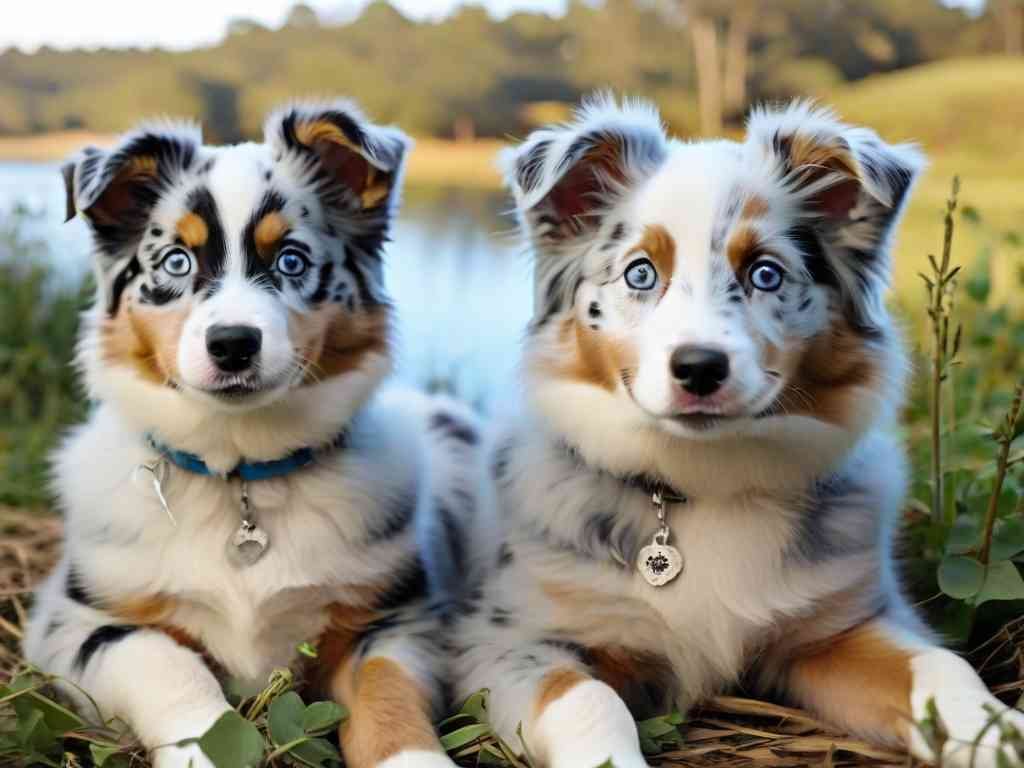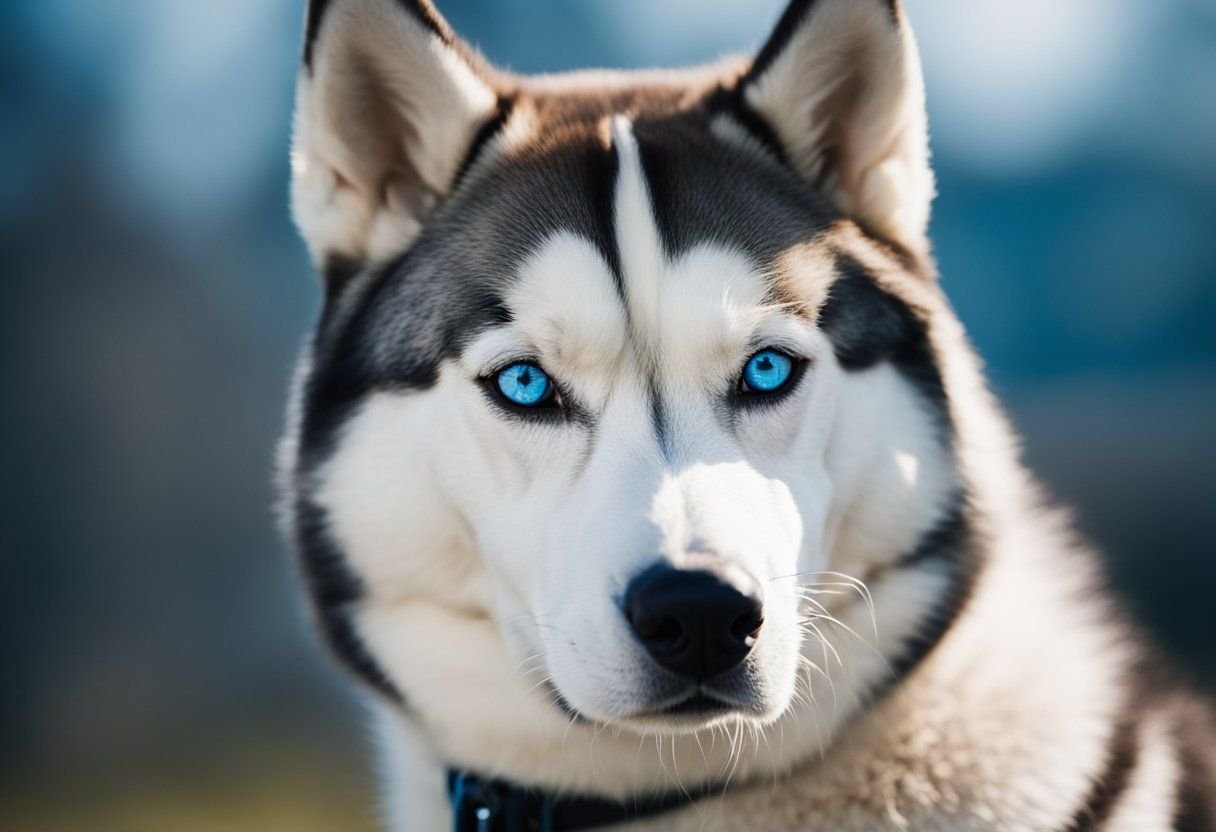Blue eyes in dogs are a rare and stunning trait that captures the attention of many dog lovers. From Siberian Huskies to Australian Shepherds, these striking eyes can come with different coat colours and unique personalities. Blue eyes in dogs result from a lack of pigment in the iris, often influenced by genetics. This genetic trait only adds to the charm and beauty of certain breeds.
You’ll find that blue-eyed dogs are not just pretty to look at but come packed with interesting histories and qualities. Breeds like Weimaraners and Dalmatians may also surprise you with their mesmerising blue gaze. These breeds, among others, often showcase a playful and friendly nature, making them great companions.
Though stunning, these dogs may face specific health concerns tied to their eye colour, such as possible hearing issues. By learning more about these beautiful breeds, you can appreciate their uniqueness and be aware of any special care they might need. Explore more about these remarkable pups and find out which one might be the perfect addition to your family.
Overview of Canine Eye Colours

Dogs have a variety of eye colours that can range from common to rare. Here’s a look at some of the most typical canine eye colours.
Brown Eyes
Brown is the most common eye colour in dogs. It can range from light to dark brown.
Amber Eyes
Amber eyes appear as a mix of yellow and brown. Breeds with blue, gray, or liver coats often have amber eyes.
Blue Eyes
Blue eyes are rarer compared to brown and amber. They are initially seen in all puppies, but often change as they grow.
Green or Hazel Eyes
Some dogs have green or hazel eyes, which are less common. These colours result from different genetic combinations.
Factors
Eye colour in dogs can vary even within the same breed. Certain genes and coat colours can influence eye colour.
Each dog’s eye colour is unique, making them even more special in their own way.
Significance of Blue Eyes in Dogs

Blue eyes in dogs can be quite striking and unusual. Most puppies start with blue eyes, but their eye colour changes as they grow. Only about 5% of adult dogs keep their blue eyes, which makes those that do seem extra special.
One reason some dogs have blue eyes is due to genetics. The ALX4 gene can cause this for a small number of dogs. This gene affects the pigments in the eye, and it’s a rare trait to have. This genetic variant usually doesn’t harm the dog’s health or vision.
Some breeds known for blue eyes:
- Siberian Huskies
- Australian Shepherds
- Border Collies
In dogs, having one blue eye, or heterochromia, is also possible. This trait might make your dog stand out even more among their furry friends.
Most blue-eyed dogs are perfectly healthy, but it’s wise to have regular vet check-ups. In rare cases, certain conditions, like deafness, can be linked to blue eyes, especially in breeds with a white coat. Always keep an eye on any new or unusual health signs.
Blue-eyed dogs are generally just like any other dog. They are full of love and personality, making them delightful companions. Whether they have one blue eye or two, they are sure to bring lots of joy and fun to your life.
Genetics Behind Blue Eyes in Dogs

Blue eyes in dogs are usually linked to specific genetic variations. Two main factors influence this: the Merle gene and other genetic influences like the duplication of DNA sequences.
The Merle Gene
The Merle gene affects a dog’s coat and eye colour, leading to blue eyes in some breeds. This gene can dilute coats to produce patterns while also causing patches of lighter hair and sometimes blue eyes. When a dog has this gene, it may pass on the trait to its offspring. It’s important to note that not all merle dogs have blue eyes, as the effect varies among individuals.
Breeds often showing the Merle gene include Australian Shepherds, Border Collies, and Shetland Sheepdogs. If you own a dog with this gene, regular vet check-ups are advised, as the Merle gene can sometimes lead to health issues like vision problems or hearing difficulties.
Other Genetic Factors
Apart from the Merle gene, other genetic variations can result in blue eyes. Some dogs have a gene variation near the ALX4 gene, which influences craniofacial, skin, and hair development. This variant can lead to a lack of pigment in the eyes, making them blue. It’s a rare occurrence, seen in around 5% of the dog population.
Breeds like Siberian Huskies and Dalmatians sometimes have this trait due to genetic factors unrelated to the Merle gene. While usually harmless, it’s a good idea to keep an eye out for any potential health concerns related to these rare genetic traits.
Popular Dog Breeds with Blue Eyes
Some dogs are known for their striking blue eyes, making them extra special. Here’s a look at some popular breeds, including the lively Siberian Husky and the energetic Australian Shepherd, and what makes them unique.
Siberian Husky
Siberian Huskies are perhaps the most famous for their blue eyes. Their stunning eyes complement their thick, fluffy coats, which can be a mix of colours like black, grey, and white. Huskies are strong and energetic, originally bred for pulling sleds over icy landscapes. They thrive in colder climates and need lots of exercise and space.
These dogs are friendly but can be independent. Training is important, as their intelligence needs control. Siberian Huskies love human company and get along with other dogs, making them wonderful companions.
Dachshund
Though not common, some Dachshunds can have blue eyes, especially if they carry the dapple gene. This small, long-bodied breed is curious and playful. Known for their keen sense of smell, Dachshunds were originally used for hunting, with their short legs aiding in digging.
Dachshunds are loyal and have a lot of character. They can be stubborn, so patient training is key. They enjoy family time and are good with children, but sometimes prefer to be the centre of attention.
Border Collie
Border Collies are renowned for their intelligence and energy. Occasionally, these agile dogs have blue eyes, adding to their striking appearance. Bred initially for herding, they excel in agility and obedience sports. Their coats can vary in colour, and they’re known for their expressive eyes, which can be blue or multi-coloured.
This breed is highly trainable and needs lots of mental and physical stimulation. Ideal for active families, Border Collies enjoy activities like running and hiking. They thrive in environments where they can work and play.
Weimaraner
The Weimaraner often has light-coloured eyes that can appear blue when they are young. As they mature, their eyes often change to a grey or amber tone. Known as the “Grey Ghost” due to their sleek, silvery coat, these dogs are athletic and elegant.
Weimaraners form strong bonds with their families and can be protective. They need lots of exercise and attention and do best with an active lifestyle. These dogs are happiest when included in family activities.
Cardigan Welsh Corgi
Some Cardigan Welsh Corgis may have blue eyes, particularly those with merle coats. These small but powerful dogs are recognised for their long bodies and short legs. Originally bred for herding cattle, they are intelligent and versatile.
Cardigans are affectionate and loyal, getting along well with other pets and children. Their alert nature makes them excellent watchdogs. Regular exercise keeps them healthy and happy, as they enjoy staying busy.
Australian Shepherd
Australian Shepherds often stand out with their beautiful blue eyes. Known for their intelligence and versatility, these dogs are often used as working animals on ranches. Their coats come in various colours, including merle, which is linked to blue eyes.
Aussies are energetic and need plenty of exercise and mental challenges. They are loyal and protective of their families, making them excellent companions. Engaging them in activities helps them thrive.
Great Dane
Occasionally, Great Danes have blue eyes, especially those with lighter coat colours. Known for their giant size and gentle nature, these dogs are often called “gentle giants.” They are friendly, affectionate, and surprisingly good with children.
Despite their size, Great Danes are well-suited for family life. They require moderate exercise and enjoy lounging around the house. Socialisation and training from a young age are important for these large yet gentle companions.
Dalmatian
Dalmatians are famous for their distinctive black or liver spots, and some may also have blue eyes. These dogs are known for their high energy and need for regular exercise. Historically, they were used as carriage dogs, guarding horses and coaches.
Dalmatians are intelligent and enjoy activities that challenge them. They make great companions for active individuals and families who can keep up with their lively nature. With proper training and socialisation, they are loyal and friendly.
Alaskan Klee Kai
Alaskan Klee Kai are small husky-like dogs that sometimes have blue eyes. They’re lively and intelligent, with compact bodies and distinct facial masks. Bred as companion dogs, they retain the active and independent nature of their larger husky relatives.
They enjoy playtime and activities that challenge their minds. Alaskan Klee Kai are loyal to their families and can be shy with strangers. Socialisation helps them become well-rounded pets.
Catahoula Leopard Dog
The Catahoula Leopard Dog often has striking blue eyes. Known for their unique spotted coats, these dogs are hard-working and energetic. Originally bred for hunting and herding in swampy areas, they are resilient and strong.
Catahoulas are intelligent and thrive in homes that can offer them both physical and mental challenges. They are protective of their territory and bond closely with their families. Regular exercise and training help keep them content and well-behaved.
Health Considerations for Dogs with Blue Eyes

Dogs with blue eyes can be both charming and unique, but there are a few health concerns to watch for. These include potential eye-related issues, hearing problems, and the need for regular eye examinations to catch any concern early.
Vision Impairments
Dogs with blue eyes may be prone to certain vision issues. Although blue eyes themselves don’t cause eyesight problems, they can sometimes be linked with conditions such as cataracts or glaucoma. These conditions can lead to vision loss if not treated promptly, so it’s important to monitor your dog’s eyes for signs like cloudiness or squinting.
Regular visits to the vet can help detect any changes in your dog’s vision early. You can also keep an eye on your dog’s behaviour at home. If you notice your dog becoming more clumsy or bumping into things, it might be time for a check-up. These simple steps can help ensure your blue-eyed pup stays healthy and happy.
Deafness Risks
Some dogs with blue eyes may also have a higher risk of hearing issues, especially those with a specific gene linked to coat colour and ear structure. Breeds like Dalmatians and Australian Shepherds are more prone to deafness if they have blue eyes. This doesn’t mean every blue-eyed dog will be deaf, but it’s something to be aware of.
Tests for hearing can easily be done by a vet, which is helpful in catching any potential issues early on. Even if a dog does have hearing loss, they can still lead a full and active life with the proper training and care.
Regular Eye Examinations
Keeping up with regular eye exams is a good practice for any dog but especially important for those with blue eyes. Vets can spot potential problems before they become serious, such as infections or progressive diseases. Catching issues early often leads to easier and more effective treatments.
Checking your dog’s eyes at home can also be helpful. Look for signs like redness or excessive tearing. If anything unusual is noticed, a prompt visit to the vet is recommended. Regular check-ups, paired with your observations, can be key in maintaining your dog’s eye health.
Breeding Ethics and Blue-Eyed Dogs
Breeding dogs with blue eyes can be exciting, but it’s important to remember that ethical breeding practices are key. Breeders should focus on the well-being of the dogs and not just the pursuit of a rare eye colour.
Health Should Come First
When you look for a blue-eyed pup, prioritise the dog’s health. Some genetic factors that cause blue eyes might be linked to health concerns. It’s crucial to ask the breeder about these risks.
Know the Breeds
Certain breeds, like Huskies and Australian Shepherds, naturally have blue eyes. Understanding which breeds are more likely to carry the blue-eye trait can help you choose a dog responsibly.
Mixed Breeds Considered
Sometimes, mixing breeds might increase the chances of blue eyes. Always ensure this is done ethically. Healthy, well-adjusted dogs should be the goal, not just unique appearances.
Choose Reputable Breeders
Look for breeders who value transparency about their dogs’ lineage and health checks. A reputable breeder will focus on maintaining healthy lineages and will offer plenty of information.
Adopt or Shop Responsibly
Adoption could be a lovely option if you’re looking for a blue-eyed dog. Rescue organisations are a great place to find your next furry friend while ensuring ethical practices. Whether you adopt or shop, make sure it’s done with care and responsibility.
Caring for a Blue-Eyed Dog

Blue-eyed dogs are not only charming but also require certain care to maintain their health and comfort. Paying attention to their eyes and diet helps ensure they stay happy and well.
Protecting Eyes from Sunlight
Blue-eyed dogs can be more sensitive to bright sunlight. Their eyes don’t have as much pigment, so protecting them is important. You might notice your dog squinting or avoiding the sun, which is a sign they need shade.
Consider walks in the early morning or late afternoon when the sun is less intense. For extra protection, you can explore dog sunglasses or hats with brims. This helps reduce exposure and keeps them comfy during outdoor adventures. Keeping an eye on any discomfort or excessive tearing is also wise.
Diet and Nutrition
Proper diet is crucial for maintaining eye health and overall well-being in blue-eyed dogs. Certain nutrients can support eye health, such as antioxidants found in carrots and leafy greens. Omega-3 fatty acids, often present in fish oils, can also contribute to healthy eyes.
Providing a balanced diet is key. Consult your vet to ensure your dog receives all the necessary nutrients. Commercial dog foods are often formulated with these in mind, but adding fresh fruits and vegetables can boost their diet.
A well-nourished dog not only feels better but may also have healthier eyes. Remember, each dog is unique, so always tailor their diet to fit their specific needs.
Myths and Misconceptions about Blue-Eyed Dogs

Many people think that all blue-eyed dogs have vision problems. This isn’t true. Most blue-eyed dogs see just fine, thanks to genetic traits, not eyesight issues.
A common myth is that any dog can have blue eyes. While it’s possible, it’s mostly seen in certain breeds like Huskies or Border Collies. Genetics mainly determine whether a dog’s eyes stay blue after puppyhood.
It’s often believed that blue eyes mean a dog is a rare breed. Yet, blue eyes can appear in mixed breeds too. Sometimes, it’s just due to gene combinations, not a sign of rarity.
Some think blue-eyed dogs are more prone to health issues. While there can be a link to hearing problems in certain cases, it’s not a rule. It’s important to rely on expert advice rather than assumptions.
Another misconception is that blue eyes make dogs more aggressive or unfriendly. A dog’s eye colour doesn’t affect its temperament or behaviour. Friendly blue-eyed dogs are quite common!
Blue eyes in dogs might appear mysterious, but they are simply another charming feature. Next time you see a blue-eyed pup, appreciate their uniqueness without jumping to conclusions!
Cultural Significance of Blue-Eyed Dogs

In various cultures, dogs with blue eyes have caught the attention of many. Some people see them as mystical or special. These striking eyes often make an impression due to their unusual appearance.
In folklore, blue eyes in dogs have sometimes been seen as a sign of magical ability or a guardian spirit. You might hear tales where these dogs are seen as protectors, keeping negative energy at bay.
In parts of modern society, blue-eyed dogs are often sought after for their unique look. Pet owners may choose blue-eyed breeds like the Siberian Husky or Australian Shepherd specifically for their unusual eye colour.
Certain cultures believe blue-eyed animals have a connection to spiritual realms. This belief can add to their appeal, making them popular in stories and legends as guides or companions.
These beautiful dogs are not just known for their looks. Often, they find roles in media and advertising, where their striking eyes are used to capture audience attention, enhancing stories or brands with a touch of uniqueness.
Even in popular films and books, blue-eyed dogs are portrayed as charming characters, captivating audiences with their endearing and sometimes mysterious appearance.
In your travels or studies, you may discover more stories where these dogs symbolise wisdom, agility, or loyalty. Each tale adds to the rich cultural patchwork surrounding these stunning pets.

